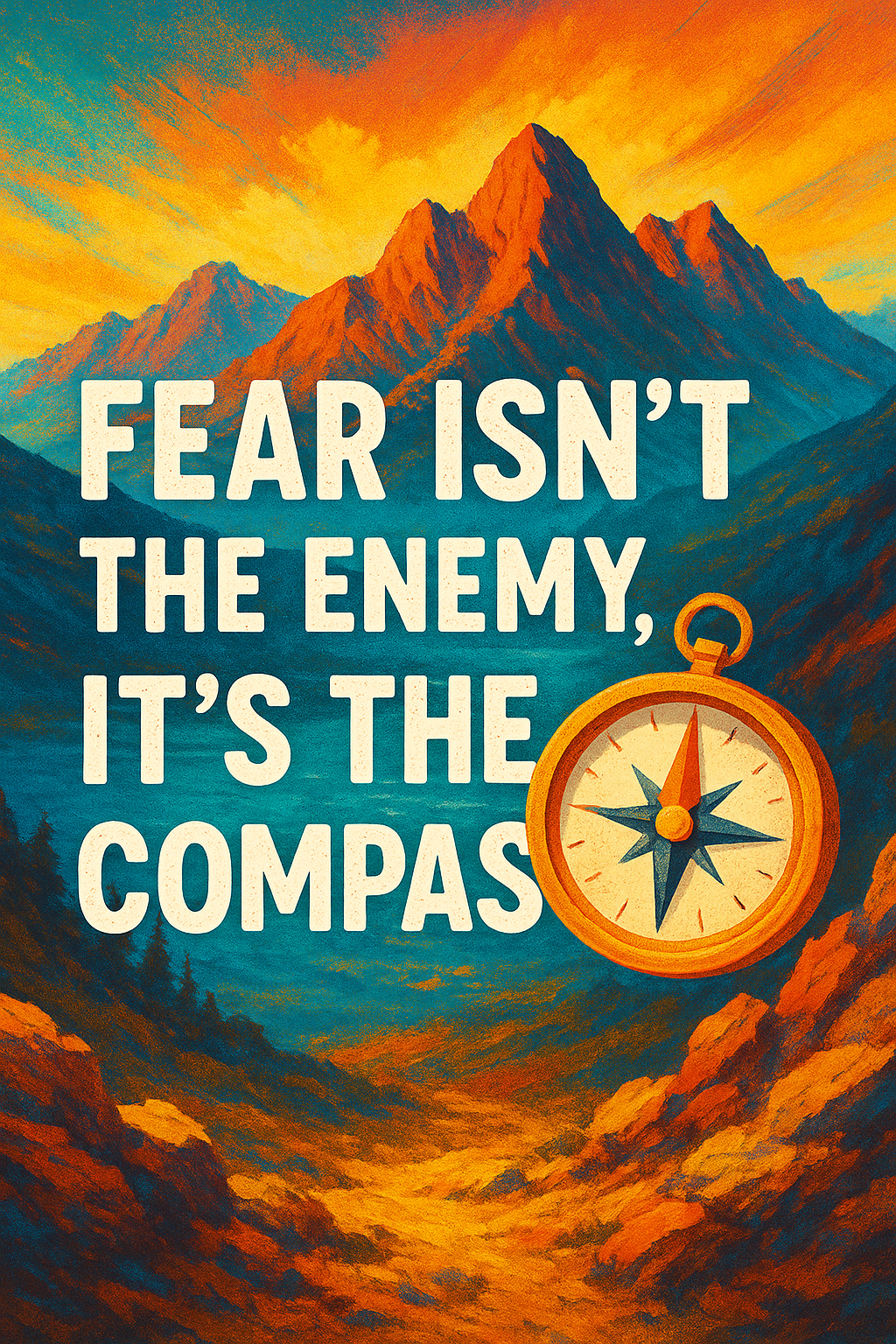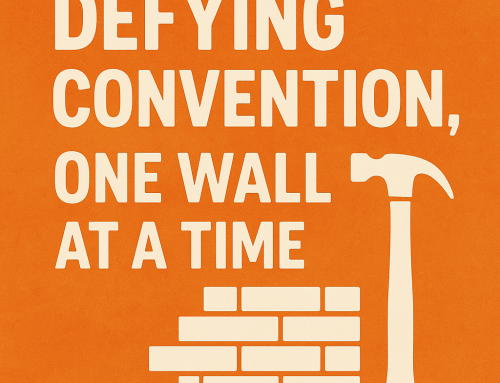Fear Isn’t the Enemy — It’s the Compass
We tend to treat fear like an enemy. Something to eliminate, outgrow, or run from. But the truth? Fear has been my greatest teacher. Over the years, I’ve learned that fear comes in two flavors: rational fears that keep us alive, and irrational fears that keep us small.
Rational Fear: The Edge of Survival
Rational fears are the ones that make sense. The fear of falling when you’re rock climbing. The fear of slamming into the ground if you jump out of an airplane. The fear of injury when skateboarding, skydiving, or pushing limits on an electric unicycle. These fears are rooted in very real dangers—they’re the voice in your head saying, “Pay attention, or you could get hurt.”
But here’s the key: rational fear doesn’t have to paralyze you. It can be managed with acceptance, training, and confidence. When you understand the risk, when you’ve built the skills, when you trust your equipment—fear becomes less of a stop sign and more of a yield sign. Slow down, look both ways, and then go.
Psychologists describe this as exposure with preparation. In controlled settings, gradual, repeated exposure to fears helps the brain adapt, reducing the amygdala’s overreaction and strengthening the prefrontal cortex’s ability to regulate it【40†source】.
I love a line often attributed to Gestalt therapy founder Fritz Perls:
“Anxiety is excitement without breath.”【40†source】
Whether or not Perls coined it directly, this insight has circulated widely in Gestalt circles and beyond. And modern science backs its essence: fear and excitement share nearly identical physiological arousal—elevated heart rate, adrenaline, and faster breathing【40†source】. The difference is often how we breathe and frame the experience. Slow, deliberate breathing engages the parasympathetic nervous system, calming the body and flipping the brain’s response from panic to focus【40†source】.
Standing at the open doorway of a plane, seconds before a tandem skydive, fear surges like a tidal wave. Then you breathe. You scream on the way down, and suddenly—fear shifts to excitement.
But self-honesty matters here. Push past rational fear without the skills to back it up, and you’re not courageous—you’re reckless. I’ve learned that the hard way. In the last few years alone, skateboarding has left me with a broken shoulder and a ruptured Achilles. Both times, healing was long and painful. But I also learned that injuries don’t end me. They taught me to progress more carefully, to assess my limits honestly, and to keep going.
Because life doesn’t end at the edge of fear. Life begins there. A sign I saw recently at the dojo said: “Life begins at the end of your comfort zone.” And it’s true.
Irrational Fear: The Ones That Live in Your Head
Irrational fears don’t come from cliffs, planes, or skateboards. They come from the space between your ears. They’re not about survival—they’re about identity. And left unchallenged, they can paralyze just as much as standing on the edge of a cliff.
For me, irrational fears have shown up as:
- Fear of losing what I have.
- Fear of not getting what I want.
- Fear of being judged.
When I was younger, those fears shaped self-fulfilling prophecies that tore my life down. And in today’s polarized, social media-driven world, irrational fears feel louder than ever.
One way irrational fear often hides is through anger. For me, anger was usually a mask. If I felt threatened, I lashed out. If I felt judged, I got defensive. But underneath, I was scared. Scared of rejection. Scared of not being enough.
Cognitive Behavioral Therapy (CBT) has a term for the kinds of thoughts I used to get stuck in: cognitive distortions.Catastrophizing—“If I fail, everything falls apart.” Mind-reading—“They must think I’m stupid.” Overgeneralizing—“I always screw this up.” These patterns can feel real, but they’re not accurate【40†source】. Naming them is the first step in loosening their grip. Talking them out with someone you trust can be even more powerful.
Now when fear shows up, I ask: “Is this rational, or irrational?” If it’s irrational, I name it for what it is, take a breath, and step forward anyway. Recognition alone doesn’t erase fear, but it shrinks it enough to move on.
A Fifth Step and a Book That Changed Me
About 30 years ago, I sat with a priest as part of the Fifth Step in a 12-step recovery program: “Admitted to God, to ourselves, and to another human being the exact nature of our wrongs.” That process forced me to look fear in the face—fears, resentments, and all the shadows I carried.
At the end of those sessions, the priest offered me a book. I never read it, but the title alone reshaped me:
“What you think of me is none of my business.”
For someone crippled by fear of judgment, that idea was revolutionary. Over time, I added my own twist:
“What I think of you is none of your business.”
Because judgment works both ways. Whether I was insecure or arrogant, I was still trapped by fear. Learning that we’re all the same, just at different points in the journey freed me from needing to compare, judge, or defend myself constantly.
From Rollercoasters to Phone Calls
Today, fear mostly shows up in small ways: picking up the phone to call a friend or client, stepping onto a stage, starting something new. The old fear rises, I breathe, and I move forward. Just like strapping into a rollercoaster—you weigh the risks, take a breath, and then ride.
Research on approach vs. avoidance motivation backs this up. Once you take a step toward what scares you under safe conditions, the brain’s fear response begins to quiet【40†source】. Courage isn’t the absence of fear—it’s fear in motion.
Faith: The Other Side of the Coin
If fear tells us what could go wrong, faith reminds us what could go right. I don’t just mean religious faith—though that can be a powerful source for some. I’m talking about the everyday kind of faith. The faith in your own skills and experience. The faith in the engineers who built the plane, the assembly workers who bolted the parts, and the mechanic who checked your car before you drove it. You hit the brakes because you believe they’ll work.
That same kind of faith shows up when you trust your training before a climb, your balance before a jump, or your own resilience after a fall. Faith doesn’t erase fear—it balances it. When fear looks ahead and says, “What if I fall?” faith quietly answers, “What if I fly?”
Takeaway
Fear isn’t the enemy—it’s the compass. Rational fear keeps you alive. Irrational fear loses its grip when you call it out and act anyway. And the bridge between fear and excitement? It’s as simple as breathing.
If you want to know where your next breakthrough lies, look for what scares you—and take one deep breath forward.
References / Further Reading
- Gestalt view of anxiety as blocked excitement: “Anxiety is excitement without breath.” Often attributed to Fritz Perls. Source: Divya Berry – Gestalt and Anxiety
- Popular attribution of “Fear is excitement without the breath” to Fritz Perls: Awaken – Fritz Perls Quotes
- Physiology of fear vs. excitement overlap: DeNovo Recovery – Anxiety vs Excitement
- Breathing and nervous system regulation: Therapeutic Counseling – How Breathing Changes Your Emotions
- Predictable fear activating reward pathways: Psychology Today – Predictable Fear
- Cognitive distortions in CBT: Healthline – 10 Cognitive Distortions
- Exposure therapy and inhibitory learning: PMC – Inhibitory Learning and Exposure Therapy

Sign up with your email and always get notifed of Avada Lifestyles latest news!






